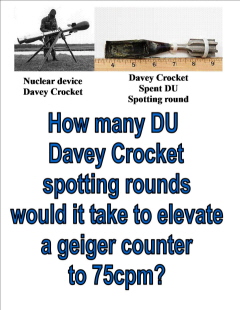

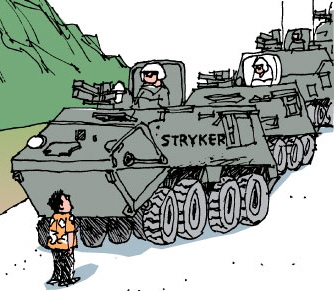

Hosted by www.Protect-Hawaii.com
and sponsored by ALF's Art Gallery.
All information is for educational purpose only. Copy, duplicate, and pass forward.
and sponsored by ALF's Art Gallery.
All information is for educational purpose only. Copy, duplicate, and pass forward.
Pohakuloa Training Area (PTA) on Hawai'i Island is contaminated with ballistic DU oxide. The Army's live fire range up on saddle road, has very strong winds almost everyday where they hold live fire training on radioactive contaminated targets. Contaminates drift off the range carried by the wind.
Could the Stryker Brigade practicing war maneuvers (at Pohakuloa, Hawai'i or O'ahu, Hawai'i) stir up the already contaminated radioactive DU DUST on the live fire firing ranges?

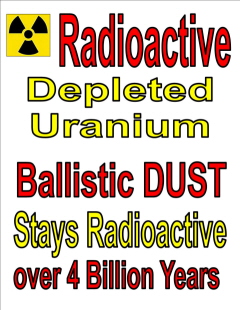
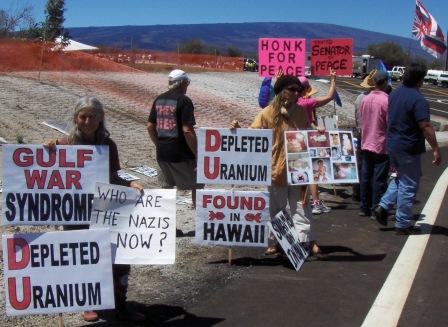

A peaceful demonstration held by concerned residents of Hawai'i at Mauna Kea State park on May 29, 2007, armed only with signs, a microphone and a Geiger counter, become alarmed when the radiation level spiked to 75 cpm on a gust of wind coming off the Pohakuloa Training Area (PTA). Normal background radiation is 5-20 cpm. The Army admits PTA is contaminated with depleted uranium but continues bombing and live fire training on contaminated radioactive ranges.
A point in fact. These beautiful islands called Hawai'i are grossly contaminated with military toxins of all kinds. The military here has been derelict in its duties to protect the island residents from dangerous toxins.
SEVEN MILITARY CAUSED SUPER-FUND SITES EXIST IN HAWAI'I
Of the many dangerous toxins polluting Hawai'i depleted uranium (DU), specifically Ballistic DU Oxide Dust. This toxic dust is nearly, if not totally, invisible. It is still a radioactive dust particle that can float on the wind for long distances and over our communities; AND its half life is 4.5 BILLION YEARS.
SEVEN MILITARY CAUSED SUPER-FUND SITES EXIST IN HAWAI'I
Of the many dangerous toxins polluting Hawai'i depleted uranium (DU), specifically Ballistic DU Oxide Dust. This toxic dust is nearly, if not totally, invisible. It is still a radioactive dust particle that can float on the wind for long distances and over our communities; AND its half life is 4.5 BILLION YEARS.
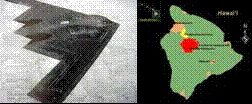
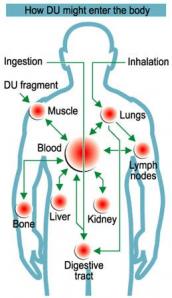
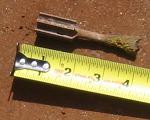
Depleted Uranium Dust Particles
These tiny little DU particles come with a powerful wallop of over 4 million electron volts, this is besides its radioactive qualities. The human cells generate about 10 electron volts. Common sense dictates that when 4 million volts contacts a living 10 volt cell the bigger stronger energy will win. The human body has trillions of cells, millions are destroyed and being made everyday. If an inhaled radioactive DU oxides gets in contact with living cell it is best if it dies. The real trouble is when the cell doesn't die but is just disrupted from its normal cycle functioning. This is called a mutation. The cell is abnormally functioning. This is also called cancer. With the internal exposure to DU oxide dust it is only a matter of time for health problems to surface. BTW: Hawai'i island has the highest incidence of cancer than any of the other islands. Ever wonder why?
These tiny little DU particles come with a powerful wallop of over 4 million electron volts, this is besides its radioactive qualities. The human cells generate about 10 electron volts. Common sense dictates that when 4 million volts contacts a living 10 volt cell the bigger stronger energy will win. The human body has trillions of cells, millions are destroyed and being made everyday. If an inhaled radioactive DU oxides gets in contact with living cell it is best if it dies. The real trouble is when the cell doesn't die but is just disrupted from its normal cycle functioning. This is called a mutation. The cell is abnormally functioning. This is also called cancer. With the internal exposure to DU oxide dust it is only a matter of time for health problems to surface. BTW: Hawai'i island has the highest incidence of cancer than any of the other islands. Ever wonder why?
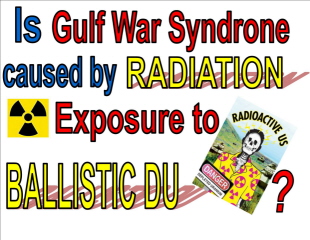

Ballistic DU Oxide Dust
(BDUOD)
BALLISTIC DU: This nuclear waste DU was obtained from nuclear industry to become a weapon, military munitions. It is used to cause great damage through being on fire; being fired or launched or catching on fire to burn. This is where the change occurs. The natural uranium (which no one would want inside our bodies) can be excreted from our bodies somewhat through our kidney but not so with ballistic DU oxide.
DU OXIDE: The act of burning turns the DU to an oxide like a glass ceramic particle. It is still radioactive, it still carries over 4 million electron volts, but once this particle enters the body, it stays in the body. It can not be excreted through the kidney.
(BDUOD)
BALLISTIC DU: This nuclear waste DU was obtained from nuclear industry to become a weapon, military munitions. It is used to cause great damage through being on fire; being fired or launched or catching on fire to burn. This is where the change occurs. The natural uranium (which no one would want inside our bodies) can be excreted from our bodies somewhat through our kidney but not so with ballistic DU oxide.
DU OXIDE: The act of burning turns the DU to an oxide like a glass ceramic particle. It is still radioactive, it still carries over 4 million electron volts, but once this particle enters the body, it stays in the body. It can not be excreted through the kidney.
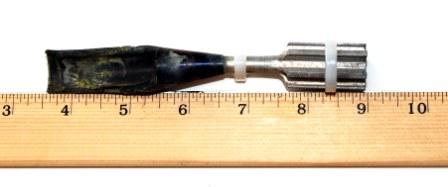
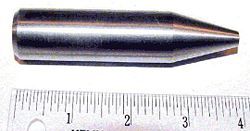
The tip of a DU spotting round.
The tip SPENT on a DU spotting round.
Would a B-52 bomber dropping 2,000 lb dummy bombs on Pohakuloa stir up the already contaminated DU on the live fire - firing range?

~~~~~~~
Monitoring the DU crisis in Hawai'i
to be continued...
Monitoring the DU crisis in Hawai'i
to be continued...
Thousands of DU spotting rounds from the Davey Crocket are suspected to have been used in the live fire training ranges in Hawai'i. See the video on the M65 Recoiless Nuclear Rifle
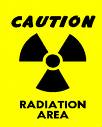

The red areas on the above map of O'ahu and Hawai'i island depicts the ILLEGAL MILITARY OCCUPATION OF HAWAI'I mostly on ceded or crown lands. The live-fire training ranges are contaminated with depleted uranium.

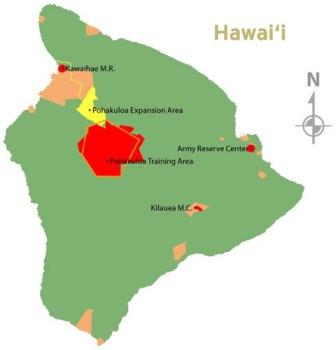



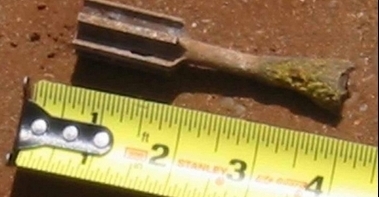
Where there is United States Military Occupation there is
US Military Unregulated Contamination and Pollution.
US Military Unregulated Contamination and Pollution.
HAWAI'I KEIKI
OUR ISLAND
CHILDREN at RISK
CHILDREN at RISK
The Starbulletin reported on March 11, 2004 that 23,000 children in Hawai'i are in Special Education and 720 children were identified as having autism. "Childhood autism in Hawai'i is growing at epidemic rate, according to Autism Society officials. No one knows why? It could be genetic or environmental (chemical exposure.)" The Department of Health (DOH) and the Department of Education (DOE) spending for special education needs has risen from approximately 75 million dollars a year in 1994 to over 350 million dollars annually in 2004.


According to the Hawai'i Birth Defects Program
One in 17 births in Hawai'i has a recognizable abnormality.
One in 17 births in Hawai'i has a recognizable abnormality.
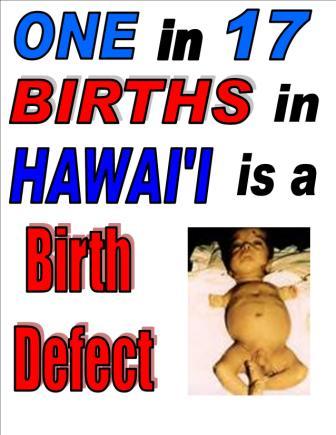
The Hawaiian cultural monitors to Schofield Barracks on O'ahu reported that Maile's sister, who was helping in the artillery field and didn't know she was pregnant...months later she delivered a baby with its intestines outside its body. No one in Hawai'i is looking at military toxins as a possible reason for this high birth defect rate in Hawai'i. Why? Why isn't the State of Hawai'i Public Health Dept. looking at the military toxins leaching into our communities? One reason is the military hides behind misinformation and plausible denial.



State of Hawai'i Health Dept. CANCER MAPS above of O'ahu and Hawai'i Island. On Hawai'i Island Kona has a 12% higher cancer rate than Hilo. And on O'ahu east of Pearl Harbor has a greater than 12% higher cancer rate per 1,000 persons. (Pearl Harbor is one of the 7 military caused superfund sites in Hawai'i.) Yet no one is looking at military toxins as a possible cause of this high incidence of cancer cases in Hawai'i. Another cancer map (shown at the right) depicts Hawai'i Island as having a higher cancer incidence of all the islands.
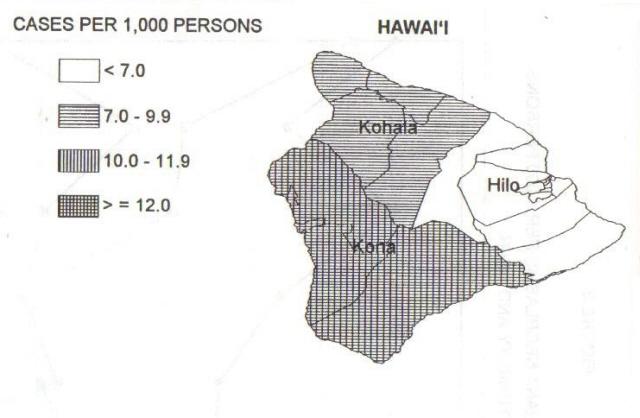
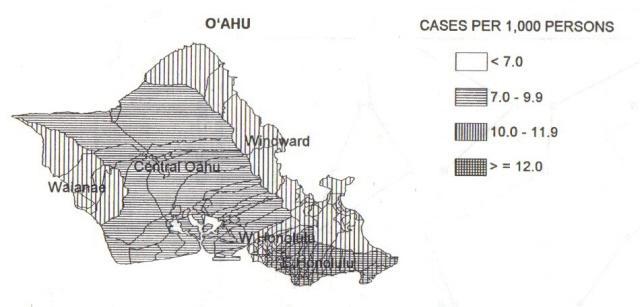

WE NEED
24/7 AIR MONITORING
AROUND ALL MILITARY LIVE FIRE RANGES LOCATED THROUGHOUT
THE HAWAIIAN ISLANDS.
THE TESTS WILL TARGET MILITARY TOXINS
AND USE COMPREHENSIVE TRANSPARENT TESTING METHODS.
24/7 AIR MONITORING
AROUND ALL MILITARY LIVE FIRE RANGES LOCATED THROUGHOUT
THE HAWAIIAN ISLANDS.
THE TESTS WILL TARGET MILITARY TOXINS
AND USE COMPREHENSIVE TRANSPARENT TESTING METHODS.
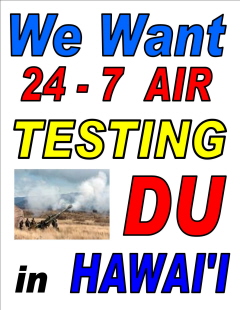
Hawai'i County
RESOLUTION 639-08
Date: July 2, 2008
RESOLUTION 639-08 URGING THE UNITED STATES MILITARY TO ADDRESS THE HAZARDS OF DEPLETED URANIUM AT THE POHAKULOA TRAINING AREA.
WHEREAS, in the early 1960's the United States Military used the
Pohakuloa Training Area for firing a formerly classified weapon, the
Davy Crockett recoilless gun, which has created the presence of
depleted uranium (DU) in the impact area at the U.S. Army Garrison,
Pohakuloa; and
WHEREAS, the World Health Organization has released several reports and scientific studies concerning the health risks from exposure to depleted uranium; and
WHEREAS, depleted uranium is a chemically toxic and radioactive heavy metal with a half-life of 4.6 billion years; and
WHEREAS, depleted uranium emits radioactive alpha particles that can cause cancer when inhaled or ingested and also cause kidney and lung damage; and
WHEREAS, there is a public health need to ensure the safe storage,
disposal, and clean-up of munitions and other products or materials
containing depleted uranium at the Pohakuloa Training Area to protect all residents of Hawai'i Island; and
WHEREAS, the United States Military is hereby requested, with
urgency, to address the potential hazards of depleted uranium at the
Pohakuloa Training Area with the following five-point plan:
1. Ordering a complete halt to B-2 bombing missions and to all live
firing exercises and other activities at the Pohakuloa Training Area
that create dust until there is an assessment and clean up of the
depleted uranium already present;
2. Establishing a permanent, high tech monitoring system with procedures to ensure air quality control;
3. Establishing a citizen monitoring system to work closely with
Military experts to assure transparency and community confidence;
4. Hosting quarterly meetings to update and inform the public; and
5.Ensuring permanent funds are available for the monitoring program;
now, therefore,
BE IT RESOLVED BY THE COUNCIL OF THE COUNTY OF HAWAI'I that the U.S. Military will incorporate the five-point plan to address the potential hazards of depleted uranium at the Pohakuloa Training Area.
BE IT FINALLY RESOLVED that the County Clerk shall forward a copy of this resolution to Colonel Howard Killian, Deputy Region Director, Army Installation Management Command-Pacific; all members of the Hawai'i State Legislature; Senator Daniel K. Inouye; Senator Daniel K. Akaka; Congressman Neil Abercrombie, and Congresswoman Mazie K. Hirono.
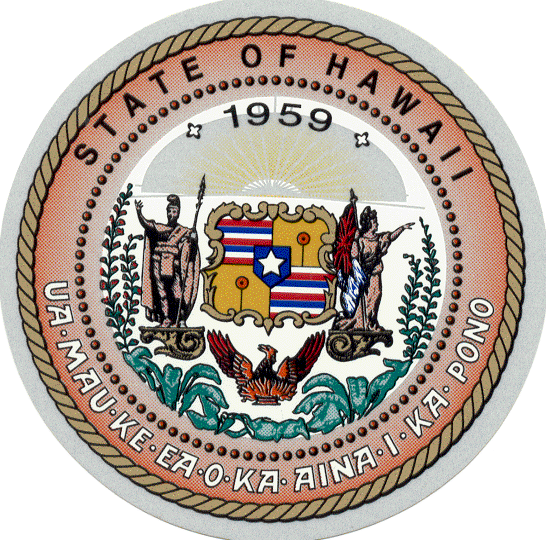
As of November 2009 the US Army has ignored County of Hawai'i requests for the precautionary principle as stated in RESOLUTION 639-08 URGING the US Military to address the Hazards of Depleted Uranium at the Pohakuloa Training Area. Instead the Military does this...
US Army Seeks License
in Hawaii from NRC.
FEDERAL ACTIONS QUESTIONED
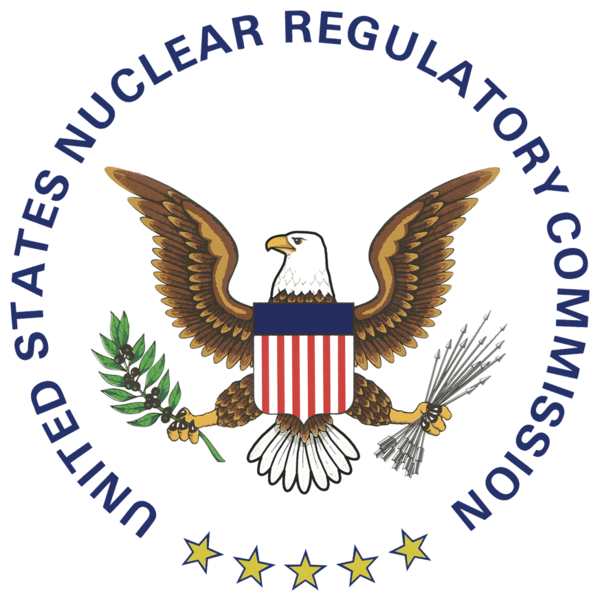
Concerned Hawaiian Residents Speak Out in Written Testimony
http://www.hi.sierraclub.org/Hawaii/mokuloa.html mh@interpac.net
Contact person: Ms. Cory Hardin
As the Nuclear Regulatory Commission (NRC) meetings in Hawai'i on a depleted uranium (DU) license for the Army, DU studies at Pohakuloa Training Area (PTA) are being questioned, and the NRC and another agency involved in studies have come under fire.
"What is proposed by the U.S. Army for future studies at PTA will fall far short of providing the best information possible at this time", said Dr. Mike Reimer, PhD, a Kona geologist, in a March letter to Army Colonel Howard Killian. "…The study design…may present itself as a feel-good approach, but it is unfortunately misleading…" he adds. Reimer's background includes chairing the environmental radioactivity section for special meetings within the American Nuclear Society; doing radiation-site contamination evaluations in Eastern Europe; and serving as guest editor for the Journal of Radioanalytical and Nuclear Chemistry.
Dr. Lorrin Pang, a WHO consultant, said "Those in charge of the [DU] assessment…do not adequately address the… form of the material, the routes of exposure, distribution in the body of non-soluble vs. soluble compounds, target organs, nor the variations in half-life and clearance from the body…", in a March e-mail. He added, "…their own referral agencies and advisors on this topic were those whose science was so flawed that they missed diagnosing the existence of Gulf War syndrome… the survey testing…will miss all large remnants of Spotter rounds…The surveys lack controls…to evaluate the specificity and sensitivity of the tests as well as control sites to compare to background radiation levels…The sampling scheme…is very subjective and hard to interpret…" Dr. Pang is a former Army doctor and has been listed in America's Best Doctors. He is also director of Maui Department of Health, but speaks on DU as a private citizen.
But an Army handout says "DU present on Hawai'i's ranges does not pose an imminent or immediate threat to human health".
"To evaluate conflicting views, we invited the Army to participate in a forum with Dr. Reimer and Dr. Pang," said Cory Harden of Sierra Club, Moku Loa group, "but it appears it will be several months before the Army is prepared to back up its conclusions in a forum."
Elsewhere, actions of both NRC and another agency involved with the PTA studies–Agency for Toxic Substances and Disease Registry (ATSDR)–have been criticized.
The NRC's recent decision to classify DU as Class A waste was called an "arbitrary and capricious mischaracterization" by the chair and a member of a Congressional Subcommittee on Energy and the Environment, who added that "requirements for safe and secure disposal of depleted uranium are much greater than what is required for Class A waste."
The ATSDR was criticized for using "flawed methods to investigate depleted uranium exposures" in New York State and refusing "to acknowledge a link between a cancer cluster in Pennsylvania and environmental contamination despite persuasive evidence". The criticism came from witnesses testifying recently to the U.S. House of Representatives Committee on Science and Technology, Subcommittee on Investigations and Oversight. (*ATSDR was also criticized by groups at the former training range in Vieques, Puerto Rico – kok)
Earlier, the Subcommittee said ATSDR's "scientifically-flawed" report and "botched response resulted in tens of thousands of survivors of Hurricanes Katrina and Rita remaining in travel trailers laden with high levels of formaldehyde" and there was "a concerted and continuing effort by the agency"s leadership to both mask their own involvement…and to push the blame…down the line".
"We urge the public to comment to the NRC and insist that recommendations from Dr. Reimer and Dr. Pang be written into the Army DU license."
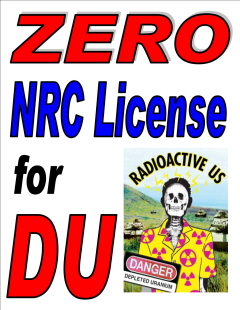
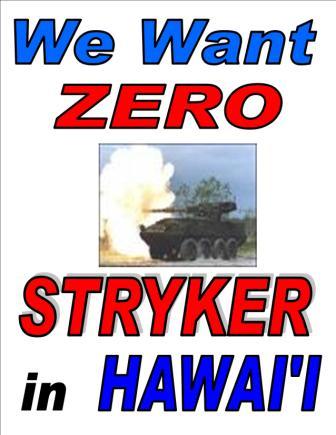
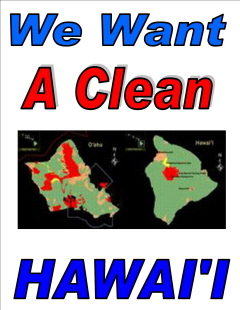
Jim Albertini
Malu ‘Aina Center for Non-violent
Education & Action
P.O.Box AB
Kurtistown, Hawai’i 96760
email: JA@interpac.net
Visit us on the web at: www.malu-aina.org
To the NRC:
I hereby request an NRC hearing on the Army's request for a depleted uranium possession-only permit.
I request to join Cory Harden and Isaac D. Harp requests and petition to intervene.
This is the basis for my contention:
l. The Army is basically ignoring Hawaii County Council's resolution 638-08, passed (8-l) on July 2, 2008 which lists eight action points, especially halting all live-fire and anything that creates dust at Pohakuloa training Area (PTA) until an assessment and clean up of the DU contamination already present. I was present at Mauna Kea State park on May 29, 2007 when citizen radiation monitors recorded readings of up to 75 counts per minute with dust devils coming directly off PTA range ll, where Davy Crockett DU spotting rounds had been fired, located l-2 miles away from Mauna Kea Park. The fact of Davy Crockett DU spotting rounds fired at PTA was confirmed by the Army in Aug. 2007, three months after our recorded radiation readings.
2. Army search of contamination is inadequate. Less than l% of PTA has been surveyed for DU contamination. There needs to be permanent independent air monitoring around the base to determine radiation coming off the base.
3. There needs to be a thorough and complete search of record archives (including classified files) other possible DU munitions used at PTA and other sites in Hawaii beyond the Davy Crockett DU spotting round.
Davy Crockett was first used at PTA in l962. The Army claims DU has been banned in training since l996. What about the years inbetween. That's 34 years.
4. Military has ignored Hawaii County Council resolution 70l-08 naming Dr. Lorrin Pang, MD as the official county representative on the DU issue with the Army.
5. The Army makes DU health hazard disclaimers without basis and ignores inhalation hazard of DU oxide.
6. PTA is Hawaiian Kingdom Sacred Land that is under illegal U.S. occupation. There is no legal basis for the U.S. to be bombing and continuing control at PTA.
7. Decommission PTA instead of expanding live-fire by a factor of two --from 7 million rounds a year to l4.8 million rounds according to the Army's Stryker EIS.
8. The State of Hawaii lease of land to PTA does not allow for a nuclear waste dump at PTA. The lease to PTA should be canceled.
9. Reports of animal tumors in the PTA area need to be investigated for possible links to DU exposure.
l0. The pre-cautionary principle needs to be a guiding light for all decision making and involving citizen participation in the decision making process. After all, it is the citizens that the Army is suppose to be defending, not endangering.
The NRC needs to be aware of the military's history of abuse in Hawaii.
In the l960s, around the same time the Army was testing DU Davy Crockett spotting rounds at PTA, the Army got a lease of State land in the Waiakea Forest Reserve, which is the city of Hilo's watershed, to do what the Army said would be "weather testing." Well the Army lied. They were not doing weather testing, they were testing chemical warfare agents in Hilo's watershed. One of the agents was nerve gas GB that can kill in minutes in dosages of one milligram, approximately l/50 of a drop. When this military abuse and lying was exposed by Hawaii Congresswoman, Patsy T. Mink, citizen outrage was expressed and the State lease to the Army was canceled. The same should be done today with PTA.
(For more details on the history of military abuse in Hawaii read The Dark Side of Paradise --Hawaii in a Nuclear World, by James V. Albertini, et all.)



Other examples of military environmental abuse: On Hawaii Island, there are 57 known present and former military sites, totaling hundreds of thousands of acres of land and coastal waters that are in need of environmental clean-up. Many of these sites are littered with unexploded ordnance and other chemical toxins. The projected cost of such clean up is in the billions of dollars. But the military claims "No money." The military has plenty of money to make its mess but little or no money to clean up its mess. This travesty of justice and abuse of the earth must end.
Quote on US flag: "There is no flag large enough to cover the shame of killing innocent people."
Thanks, But No Tanks
Story by Kyle Kajehiro
Future Generations are Counting on Us.
Nuclear-Free Blessings,
Marya Mann, Ph. D.
Please feel free to contact me at
www.maryamann.com
Hawaii Must Not Become Nuclear Waste Dump
NRC testimony by Lindafaye Kroll BSN
email lindafaye@alfsartgallery.com

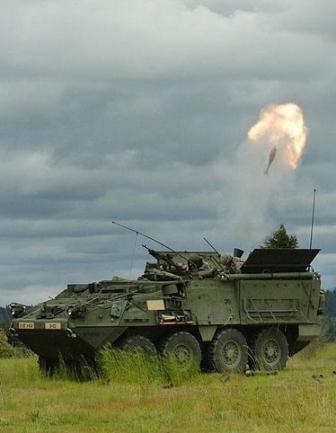
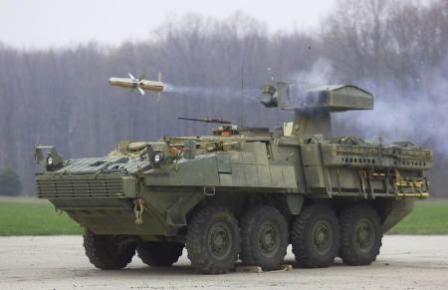
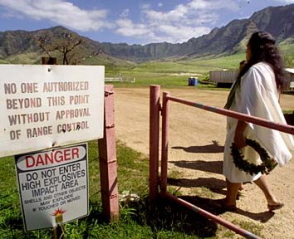
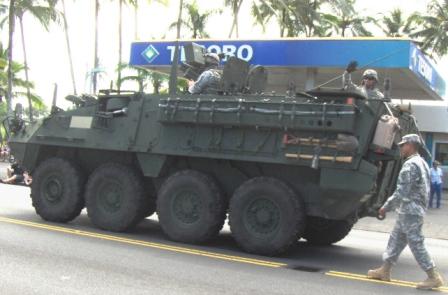
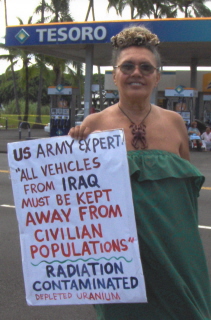
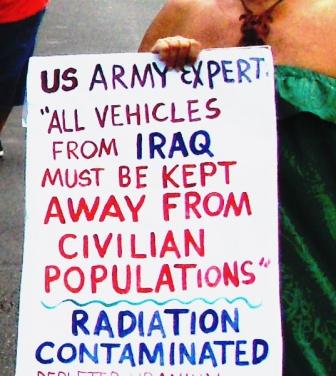
Veterans Day Parade Hilo Hawai'i 2009
STRYKERS FIRING...
REAL AND LETHAL...
AMMUNITIONS



NRC Denies Request of Island Residents For Hearing Challenging Army's Request For License To Possess Depleted Uranium
Submitted by Chip on Tue, 2010-03-02 04:38.
* Human Rights
* Military Industrial Complex
* Nuclear
Nuclear Regulatory Commission (NRC) denies request of Island residents for a hearing challenging the Army's request for a license to possess DU radiation | Press Release Feb. 24, 2010
Jim Albertini, one of four Hawaii residents challenging the Army's request for a license to possess Depleted Uranium (DU) radiation at Pohakuloa Training Area (PTA) and Schofield Barracks said: "The NRC's order denying us a hearing is not surprising. The NRC has never denied a license request. The NRC appears to be a rubber stamp for the military and the nuclear industry, much like the so-called Bank regulators are a rubber stamp for the Wall St. Banksters ongoing criminal enterprise. The deck is stacked against the citizen and taxpayer in challenging policies that favor special interests. The heart of the issue is ignored and the case is reduced to using procedural legal technicalities to deny citizens their rights and their voice. Legal bureaucrats in Rockville, Maryland, paid with our tax dollars, have determined that we who live here in Hawaii have no standing to challenge the military poisoning of our island home with radiation. What kind of justice, freedom and democracy is that?"
Albertini said "In plain language, a military license to possess DU in the heart of our island is a license for a nuclear waste dump. The state of Hawaii (BLNR) that leases land to the military on its 133,000 acre PTA base for 65 years for a total of $1.00 should cancel the lease. We need to malama the aina not abuse it."
On 2/24/2010 9:17 AM, Docket, Hearing wrote:
Attached is a Licensing Board Memorandum and Order (Denying Requests for Hearing) (LBP-10-04), US Army Installation Command (Schofield Barracks, Oahu, Hawaii, and Pohakuloa Training Area, Island of Hawaii, Hawaii), Docket No. 40-9083, served February 24, 2010.
Nancy Greathead
Rulemakings and Adjudications Staff, Office of the Secretary
PRESS RELEASE:
Depleted Uranium Hearing Denied
February 24, 2010
by Cory Hardin Sierra Club Moku Loa Group
Cory Harden
mh@interpac.net
For immediate release
February 24, 2010, Hilo, Hawai’i
Attachment -- denial of request for hearing
DEPLETED URANIUM HEARING DENIED
Petitioners challenging an Army application for a license to possess depleted uranium (DU) expressed disappointment after the Atomic Safety and Licensing Board of the Nuclear Regulatory Commission (NRC) ruled that the petitioners lack standing.
The petitioners are Jim Albertini of Malu Aina Center for Non-violent Education & Action, Cory Harden, and Isaac Harp, all from Hawai’i Island, and Luwella Leonardi of O’ahu.
The petitioners questioned the Army’s assessment of hazards from DU spotting rounds found in Hawai’i. The Army denied having DU in Hawai’i until 2006, when citizen groups announced they had obtained Army e-mails reporting the 2005 discovery of DU spotting rounds at Schofield Barracks on the island of O’ahu. The spotting rounds were part of a classified Davy Crockett weapon system used in the 1960s. The Army acknowledged the find, and later found more spotting rounds at Pohakuloa Training Area (PTA) on Hawai‘i Island. The rounds were also distributed to twelve other states and three foreign countries in the 1960s. The Army says worldwide it had about 75,000 rounds, each about eight inches long and containing about six and a half ounces of DU alloy.
Albertini, Harden, and Harp said Army searches, reports, and air monitoring plans for DU at Pohakuloa Training Area (PTA) on Hawai’i Island are inadequate, so airborne DU from live-fire and dummy bombs impacting undiscovered spotting rounds may go undetected. They noted that the same concerns were expressed by several professionals: Dr. Mike Reimer, a geologist, and Dr. Marshall Blann, a consultant to Los Alamos National Laboratory, both from Kona; and Dr. Lorrin Pang from Maui, a former Army doctor who is a consultant to the World Health Organization.
Albertini and Harden called for a search of classified and unclassified records by all military forces in Hawai’i for other forgotten radioactive hazards.
Albertini called for independent testing and for investigation of reports that animals from the PTA area have tumors. He said the Army has ignored Hawai‘i County Council resolutions concerning DU.
Albertini and Harp called for a halt to live-fire and other activities that might disperse dust at PTA, and questioned whether the Army has disclosed the full extent of its DU use in Hawai’i
Harp expressed concern about high rates of cancer and of a rare neurological disease on Hawai‘i Island.
Leonardi said the Army dug up and trucked out DU-contaminated soil at Schofield, but the Army said the soil was uncontaminated.
“I’m somewhat encouraged by two things--NRC agrees there may be more DU than the Army claims, and NRC wants a ban on high-explosive munitions in DU areas written into the license,” said Harden.
Albertini said, “PTA should be “shut down…cleaned up and returned to its rightful owners--the independent nation of Hawai’i.” He added, “We are all downwind.“
Harp, a Native Hawaiian, said, “The time has come for the United States to clean up their messes, repair their damages, and de-occupy our country,” and added, “It is the Army that has no standing here.”
Submitted by Chip on Tue, 2010-03-02 04:38.
* Human Rights
* Military Industrial Complex
* Nuclear
Nuclear Regulatory Commission (NRC) denies request of Island residents for a hearing challenging the Army's request for a license to possess DU radiation | Press Release Feb. 24, 2010
Jim Albertini, one of four Hawaii residents challenging the Army's request for a license to possess Depleted Uranium (DU) radiation at Pohakuloa Training Area (PTA) and Schofield Barracks said: "The NRC's order denying us a hearing is not surprising. The NRC has never denied a license request. The NRC appears to be a rubber stamp for the military and the nuclear industry, much like the so-called Bank regulators are a rubber stamp for the Wall St. Banksters ongoing criminal enterprise. The deck is stacked against the citizen and taxpayer in challenging policies that favor special interests. The heart of the issue is ignored and the case is reduced to using procedural legal technicalities to deny citizens their rights and their voice. Legal bureaucrats in Rockville, Maryland, paid with our tax dollars, have determined that we who live here in Hawaii have no standing to challenge the military poisoning of our island home with radiation. What kind of justice, freedom and democracy is that?"
Albertini said "In plain language, a military license to possess DU in the heart of our island is a license for a nuclear waste dump. The state of Hawaii (BLNR) that leases land to the military on its 133,000 acre PTA base for 65 years for a total of $1.00 should cancel the lease. We need to malama the aina not abuse it."
On 2/24/2010 9:17 AM, Docket, Hearing wrote:
Attached is a Licensing Board Memorandum and Order (Denying Requests for Hearing) (LBP-10-04), US Army Installation Command (Schofield Barracks, Oahu, Hawaii, and Pohakuloa Training Area, Island of Hawaii, Hawaii), Docket No. 40-9083, served February 24, 2010.
Nancy Greathead
Rulemakings and Adjudications Staff, Office of the Secretary
PRESS RELEASE:
Depleted Uranium Hearing Denied
February 24, 2010
by Cory Hardin Sierra Club Moku Loa Group
Cory Harden
mh@interpac.net
For immediate release
February 24, 2010, Hilo, Hawai’i
Attachment -- denial of request for hearing
DEPLETED URANIUM HEARING DENIED
Petitioners challenging an Army application for a license to possess depleted uranium (DU) expressed disappointment after the Atomic Safety and Licensing Board of the Nuclear Regulatory Commission (NRC) ruled that the petitioners lack standing.
The petitioners are Jim Albertini of Malu Aina Center for Non-violent Education & Action, Cory Harden, and Isaac Harp, all from Hawai’i Island, and Luwella Leonardi of O’ahu.
The petitioners questioned the Army’s assessment of hazards from DU spotting rounds found in Hawai’i. The Army denied having DU in Hawai’i until 2006, when citizen groups announced they had obtained Army e-mails reporting the 2005 discovery of DU spotting rounds at Schofield Barracks on the island of O’ahu. The spotting rounds were part of a classified Davy Crockett weapon system used in the 1960s. The Army acknowledged the find, and later found more spotting rounds at Pohakuloa Training Area (PTA) on Hawai‘i Island. The rounds were also distributed to twelve other states and three foreign countries in the 1960s. The Army says worldwide it had about 75,000 rounds, each about eight inches long and containing about six and a half ounces of DU alloy.
Albertini, Harden, and Harp said Army searches, reports, and air monitoring plans for DU at Pohakuloa Training Area (PTA) on Hawai’i Island are inadequate, so airborne DU from live-fire and dummy bombs impacting undiscovered spotting rounds may go undetected. They noted that the same concerns were expressed by several professionals: Dr. Mike Reimer, a geologist, and Dr. Marshall Blann, a consultant to Los Alamos National Laboratory, both from Kona; and Dr. Lorrin Pang from Maui, a former Army doctor who is a consultant to the World Health Organization.
Albertini and Harden called for a search of classified and unclassified records by all military forces in Hawai’i for other forgotten radioactive hazards.
Albertini called for independent testing and for investigation of reports that animals from the PTA area have tumors. He said the Army has ignored Hawai‘i County Council resolutions concerning DU.
Albertini and Harp called for a halt to live-fire and other activities that might disperse dust at PTA, and questioned whether the Army has disclosed the full extent of its DU use in Hawai’i
Harp expressed concern about high rates of cancer and of a rare neurological disease on Hawai‘i Island.
Leonardi said the Army dug up and trucked out DU-contaminated soil at Schofield, but the Army said the soil was uncontaminated.
“I’m somewhat encouraged by two things--NRC agrees there may be more DU than the Army claims, and NRC wants a ban on high-explosive munitions in DU areas written into the license,” said Harden.
Albertini said, “PTA should be “shut down…cleaned up and returned to its rightful owners--the independent nation of Hawai’i.” He added, “We are all downwind.“
Harp, a Native Hawaiian, said, “The time has come for the United States to clean up their messes, repair their damages, and de-occupy our country,” and added, “It is the Army that has no standing here.”
NRC CHALLENGED - NRC ANSWERS
Four Hawaii Residents Challenge the NRC
NRC Answers - Hawaii Residents Have No Standing
Four Hawaii Residents Challenge the NRC
NRC Answers - Hawaii Residents Have No Standing




UPDATE: APRIL 28, 2010
http://bigislandweekly.com/articles/2010/04/28/read/news/news02.txt
NRC to Army: DU monitoring plan won't work
By Alan D. Mcnarie
Wednesday, April 28, 2010 12:04 PM HST
The U.S. Army's plan to monitor the air over Pohakuloa Training Area for depleted uranium has drawn sharp criticism from some Native Hawaiians, environmentalists, activists and independent experts. Now the Army has gotten an admonishment from the Nuclear Regulatory Commission.
"We have concluded that the Plan will provide inconclusive results for the U.S. Army as to the potential impact of the dispersal of depleted uranium (DU) while the Pohakuloa Training Area is being utilized for aerial bombardment or other training exercises," wrote Rebecca Tadesse, Chief of the NRC's Materials Decommissioning Branch, in a recent letter to Lt. General Rick Lynch, who heads the Army's Installation Management Command.
Tadesse and her staff reached that conclusion after reviewing the draft plan proposed by the Army and ORISE, the Oak Ridge Institute for Science and Education, which would conduct the monitoring for aerial DU contamination at Pohakuloa and at various other locations around the island. The NRC experts concluded that the plan was inadequate in several areas: the number of air samples planned was "insufficient," optimum locations for monitoring needed to be determined and established, and "Continuous monitoring should be performed during the testing and also prior to and following testing to determine background conditions," so that the army would have a basis for comparison with any high readings. The letter also noted that the army proposed to conduct its air monitoring specifically during live firing exercises -- even though the Army had told the NRC that it would not "use high explosives and bombs in areas where DU is present."
"If that is true, why would there be an expectation that DU might be dispersed during such training exercises?" Tadesse asked.
The Army's handling of the DU issue at Pohakuloa is also drawing fire from some independent experts, including retired army doctor Lorrin Pang, Los Alamos National Laboratory consultant Dr. Marshall Bland, and Dr. Michael Reimer, a retired geologist with a background in radiation monitoring. And Sierra Club researcher Cory Harden has used recently released Army documents to challenge the Army's own estimates of how much DU may have been released into the environment at Pohakuloa.
"The NRC review seems to vindicate Dr. Pang and myself for claiming that the monitoring was insufficient," Reimer told BIW.
According to the NRC's Greg Pukin, his agency doesn't generally have jurisdiction over weapons, but does have authority over DU and other radionuclides. The Army has applied to the NRC for a permit to possess DU at Pohakuloa -- a permit that, if granted, could allow the recently discovered remains of depleted uranium spotter rounds from the Army's cold-war-era Davy Crockett nuclear howitzer on site at the training area -- spotter rounds whose presence in Hawai'i the army had denied until a citizen's group unearthed an e-mail about their discovery in 2006. A group of local residents, including Harden, antiwar activist Jim Albertini, and native Hawaiian activist Isaac Harp had filed a challenge to the Army's application on the grounds that its monitoring and clean-up plans were inadequate, but were recently denied standing by the NRC. Harp has appealed that denial.
Both Pang and Reimer testified as experts on April 14 at an NRC phone conference to consider Harp's complaint. In addition to noting Tadesse's criticisms, Reimer observed that the 5-micron filters that the army planned to use to capture possible DU particles for monitoring were a bit on the coarse side.
"Five-micron size [particles] would fall out within a mile," he said. "Smaller sizes may be carried by the wind." He recommended .45-micron filters.
Pang also challenged the army's general credibility by citing a number of former army statements about DU that Pang said simply weren't true.
"The Army stated to the Dept of Health Environmental Chief that inhaled DU (from exploding weaponry) was not a worry since DU is heavier than air and would not become airborne, therefore not inhaled," he noted, for example. He testified that Army consultants, when discussing the amount of DU needed to produce radiation readings reported by civilian monitors at Pohakuloa, had held out their hands to indicate chunks the size of basketballs.
Pang also claims that an Army study setting human safety thresholds for DU inhalation was scientifically flawed.
"That study has been widely, publicly debunked by the scientific community," he said. "The Army investigators did not count effects like tumors (both malignant and benign) in the exposed group."
"The kind of air monitoring that the Army is using, they'll never find it," commented Harden at the conference call.
Harden also challenged an Army estimate that about 700 Davy Crocket spotter rounds may have been fired at Pohakuloa.
"To back up their claim they quoted from a report, which I only managed to obtained after ten months of repeated requests," testified Harden. Their quote for the lower number does not match my copy of the report.... For soldiers to follow training manual requirements of that time, about 2,000 spotting rounds would have been needed at Pohakuloa. Now the Army didn't find 2,000 spotting rounds recently at Pohakuloa Training Area, only four fragments. They speculate that range clearance may have been done, but offer no evidence to support this theory."
Based on the discrepancies, the Army's critics argued that the NRC simply couldn't trust what the Army said about DU in Hawaii - nor could the public.
"Since we can't rely on the military to shine their light on the hazards its left behind, we need help from NRC," Hardin concluded.
*see comments at web site............
NRC to Army: DU monitoring plan won't work
By Alan D. Mcnarie
Wednesday, April 28, 2010 12:04 PM HST
The U.S. Army's plan to monitor the air over Pohakuloa Training Area for depleted uranium has drawn sharp criticism from some Native Hawaiians, environmentalists, activists and independent experts. Now the Army has gotten an admonishment from the Nuclear Regulatory Commission.
"We have concluded that the Plan will provide inconclusive results for the U.S. Army as to the potential impact of the dispersal of depleted uranium (DU) while the Pohakuloa Training Area is being utilized for aerial bombardment or other training exercises," wrote Rebecca Tadesse, Chief of the NRC's Materials Decommissioning Branch, in a recent letter to Lt. General Rick Lynch, who heads the Army's Installation Management Command.
Tadesse and her staff reached that conclusion after reviewing the draft plan proposed by the Army and ORISE, the Oak Ridge Institute for Science and Education, which would conduct the monitoring for aerial DU contamination at Pohakuloa and at various other locations around the island. The NRC experts concluded that the plan was inadequate in several areas: the number of air samples planned was "insufficient," optimum locations for monitoring needed to be determined and established, and "Continuous monitoring should be performed during the testing and also prior to and following testing to determine background conditions," so that the army would have a basis for comparison with any high readings. The letter also noted that the army proposed to conduct its air monitoring specifically during live firing exercises -- even though the Army had told the NRC that it would not "use high explosives and bombs in areas where DU is present."
"If that is true, why would there be an expectation that DU might be dispersed during such training exercises?" Tadesse asked.
The Army's handling of the DU issue at Pohakuloa is also drawing fire from some independent experts, including retired army doctor Lorrin Pang, Los Alamos National Laboratory consultant Dr. Marshall Bland, and Dr. Michael Reimer, a retired geologist with a background in radiation monitoring. And Sierra Club researcher Cory Harden has used recently released Army documents to challenge the Army's own estimates of how much DU may have been released into the environment at Pohakuloa.
"The NRC review seems to vindicate Dr. Pang and myself for claiming that the monitoring was insufficient," Reimer told BIW.
According to the NRC's Greg Pukin, his agency doesn't generally have jurisdiction over weapons, but does have authority over DU and other radionuclides. The Army has applied to the NRC for a permit to possess DU at Pohakuloa -- a permit that, if granted, could allow the recently discovered remains of depleted uranium spotter rounds from the Army's cold-war-era Davy Crockett nuclear howitzer on site at the training area -- spotter rounds whose presence in Hawai'i the army had denied until a citizen's group unearthed an e-mail about their discovery in 2006. A group of local residents, including Harden, antiwar activist Jim Albertini, and native Hawaiian activist Isaac Harp had filed a challenge to the Army's application on the grounds that its monitoring and clean-up plans were inadequate, but were recently denied standing by the NRC. Harp has appealed that denial.
Both Pang and Reimer testified as experts on April 14 at an NRC phone conference to consider Harp's complaint. In addition to noting Tadesse's criticisms, Reimer observed that the 5-micron filters that the army planned to use to capture possible DU particles for monitoring were a bit on the coarse side.
"Five-micron size [particles] would fall out within a mile," he said. "Smaller sizes may be carried by the wind." He recommended .45-micron filters.
Pang also challenged the army's general credibility by citing a number of former army statements about DU that Pang said simply weren't true.
"The Army stated to the Dept of Health Environmental Chief that inhaled DU (from exploding weaponry) was not a worry since DU is heavier than air and would not become airborne, therefore not inhaled," he noted, for example. He testified that Army consultants, when discussing the amount of DU needed to produce radiation readings reported by civilian monitors at Pohakuloa, had held out their hands to indicate chunks the size of basketballs.
Pang also claims that an Army study setting human safety thresholds for DU inhalation was scientifically flawed.
"That study has been widely, publicly debunked by the scientific community," he said. "The Army investigators did not count effects like tumors (both malignant and benign) in the exposed group."
"The kind of air monitoring that the Army is using, they'll never find it," commented Harden at the conference call.
Harden also challenged an Army estimate that about 700 Davy Crocket spotter rounds may have been fired at Pohakuloa.
"To back up their claim they quoted from a report, which I only managed to obtained after ten months of repeated requests," testified Harden. Their quote for the lower number does not match my copy of the report.... For soldiers to follow training manual requirements of that time, about 2,000 spotting rounds would have been needed at Pohakuloa. Now the Army didn't find 2,000 spotting rounds recently at Pohakuloa Training Area, only four fragments. They speculate that range clearance may have been done, but offer no evidence to support this theory."
Based on the discrepancies, the Army's critics argued that the NRC simply couldn't trust what the Army said about DU in Hawaii - nor could the public.
"Since we can't rely on the military to shine their light on the hazards its left behind, we need help from NRC," Hardin concluded.
*see comments at web site............
NRC to Army: DU
Monitoring Plan Won't Work!
Monitoring Plan Won't Work!







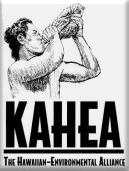


http://www.bigislandweekly.com/articles/2010/06/30/read/news/news02.txt
Army official: We never meant to clean up DU
By Alan D. Mcnarie
Wednesday, June 30, 2010 11:08 AM HST
According to a high Army official, the Army never intended to remove depleted uranium ammunition remnants from Pohakuloa Training Area and Schofield Barracks, and it has no plans to do so for as long as the firing ranges at those facilities are still in use.
"The Army requested a license for possession, not decommissioning, of the legacy DU at the affected Army installations," wrote Deputy Assistant Secretary to the Army Addison D. "Tad" Davis IV to Congresswoman Mazie Hirono on May 26 of this year. Davis added, "Currently the Army has no plans for the removal of the legacy DU. The ranges containing DU are still in use, and most, if not all, of these ranges also contain unexploded ordnance, which is significantly more hazardous than any DU that might be present on these ranges. Should those ranges be scheduled for closure at some future date, the Army will address the DU present as part of the range closure...."
The "legacy DU" referred to in the letter is believed to be fragments of spotting rounds from cold-war-era Davy Crockett nuclear artillery. In 2008, the Army submitted an application to the Nuclear Regulatory Commission for a permit to "possess" the DU; its original permit had expired in 1964. The NRC's ruling on that application is still pending, though the NRC has criticized the Army's plan to monitor the DU in the area as ineffective. (See "NRC to Army: DU Monitoring Plan Won't Work" in the archives at http://www.bigislandweekly.com.) A sub-agency called the Federal and State Materials and Environmental Management Programs is entertaining a petition from Hawaiian activist Isaac Harp to discipline the army over the expired permit. Hirono had asked Davis what the army had done to address public concerns about "environmental, health and safety" hazards that the DU posed.
The Army has repeatedly contended that the DU does not present a significant hazard to the island's population. Davis's letter to Hirono continued to maintain the Army's position. He claimed that the soil concentration of DU at the Army ranges was estimated at 1-4 pCi/g (picocuries of DU per gram of soil), which averaged "much less than the NRC decommissioning levels of uranium in soil (14 pCi/g of Uranium 238, the major constituent of DU), and are not much above soil concentrations of naturally occurring uranium."
"The Army has collected numerous air and soil samples, none of which indicate that the DU at Hawaii's ranges has migrated off-range...," Davis contended.
Not so, says Dr. Lorrin Pang, a former Army doctor and frequent critic of the Army's handling of the DU issue.
"That's absolutely not true. Even their own tests at Waiki'i [on the Saddle Road near Pohakuloa] found it [DU] in dust at low levels. I think the correct scientific interpretation is, it was there," Pang told the Big Island Weekly.
Pang also challenged Davis's assertion that "Many independent scientific studies of depleted uranium in the environment show that DU presents no significant 'environmental, health and safety [hazard],' especially at the soil concentrations of the DU on Hawaii's ranges." Pang noted that the NRC itself had criticized the Army's monitoring protocols as inadequate; he maintained that the Army simply didn't know, yet, how much DU was located at Pohakuloa.
"You don't have a system in place to monitor and baseline, and then you're gonna tell me the risks?" he asked skeptically. "Tad Allen isn't a scientist. He's an MBA from Harvard. If he makes these statements, he'd better refer to scientists who will defend them...
First of all, if you say, we never intended to clean it up, how much is there? You don't even know."
The proper scientific approach, he maintained was, "First tell me, how much [DU] is there. Then you've got to tell, me, what is the risk? Then you've got to tell me the response: if you're going to clean it up or not."
And the army's own "friendly fire" studies on service people exposed to DU were so badly flawed, he maintained, that the researchers hadn't even recorded tumors, so the health risks were also not known. Without knowing either the quantity of DU or the health risk, the proper course of action was impossible to determine.
He added that that appropriate course of action might turn out to be something other than cleaning up the DU.
"Maybe they don't have to clean it up," he said. "Maybe they just promise never to use it again. Maybe they keep the dust down."
Davis's letter also provoked a response from Cory Harden, who has been monitoring the DU controversy for the Sierra Club. Harden noted that when Davis wrote , "the Army has collected numerous soil and air samples, none of which indicate that the DU...has migrated off range," he didn't mention testimony by geologist and radiation expert Dr. Mike Reimer, who had reviewed the Army's proposed DU monitoring system and found that the holes in the filters on the Army's detection devices were "ten times too large."
She also questioned Davis' statement that the DU disposal problem would be addressed when the firing ranges were finally decommissioned. She noted that after the military took over Kaho'olawe for a bombing range, Pres. Dwight Eisenhower had promised to return the island in habitable condition - but when it was finally returned 50 years later, massive bombing had cracked the caprock, draining the island's freshwater supply, and most of the island's land still had not been entirely cleared of ordnance.
What the Army actually does with the DU, however, may depend not on what it intended or intends to do, but on what the NRC tells it to do. Few expect the NRC not to grant the Army a permit to possess the DU - after all, the stuff is already in the ground - but it may well impose conditions on the Army, including a more viable monitoring program and possibly a cleanup strategy.
UPDATE: June 30, 2010
Army Official: We never
meant to clean up DU
meant to clean up DU
Dr. Lorrin Pang responds: (in his private capacity)
as to the "standing" of Hawai'i residents.
I carefully read the NRC’s original ruling that the community members had no “standing”. Essentially the NRC ask for proof of harm. We have no proof of harm – but claim that there has been no proof of safety. There is no monitoring of what DU levels and health risks truly exist. If the NRC allows activities until harm is shown this is a very foolish principle and directly contradicts the precautionary principle. The precautionary principle becomes most important when contaminants are hard to remove and persist in the environment. In light of the BP oils disaster does any regulatory agency now deny the importance of precaution?
The only remaining issue is whether or not the Army’s “assurances” are enough to satisfy reasonable criteria of precaution. The Army has made grossly misleading and inaccurate public statements regarding the issue of DU risks. Often questions were not entertained during presentations and written questions were never answered. A few examples are as follows: Army said: live firing at PTA did not and did occur; DU cannot be aerosolized as fine dust since it is heavier than air; High counts detected by civilian air monitors are only compatible with large chucks of DU (impossible to become airborne); The friendly fire incident showed that US soldiers exposed to DU aerosolized compounds were in perfect health (when in fact tumors – both malignant and benign were ignored by the Army investigators); The Army used ONLY Dave Crockett rounds at PTA (when in fact the original agreement was that they had used AT LEAST these rounds, since record keeping is too sloppy to assure that other types of round were not used). The Army also has a biased incorrect interpretation of the Waikii dust sample data.
It is the Army’s assurances of safety have no standing (proof). Worse yet, some of their statements are not merely unproven – they have been proven to be scientifically wrong. Since safety has not been shown the Precautionary Principle dictates an interruption of dust making activity until we can be reasonably sure of safety. The BP oils spill is too impressive to ignore more pertinent analogies. BP and federal regulators gave assurances that the deep drilling would be safe. The effectiveness of safeguards were not merely unknown – tests had shown that the majority of the time they actually failed. Reality confirmed this. In hindsight all agreed to be more cautious – to enact a moratorium until we could be reasonably sure of safety (monitoring, contingency measures for containment and clean-up). What applies to oil in the gulf should apply to DU military ranges.
Beside the message the Army has distorted the process. They promised us transparency. Attending their briefings is by invite only. I was not invited. Our briefings are always open to the public and the Army sometimes refuses to attend. Transparency? Need I make more BP oil spill analogies? Perhaps it is time for the President and the Dept of Justice to get involved. Maybe this time it is really too late. Lorrin (emphasis added)
The only remaining issue is whether or not the Army’s “assurances” are enough to satisfy reasonable criteria of precaution. The Army has made grossly misleading and inaccurate public statements regarding the issue of DU risks. Often questions were not entertained during presentations and written questions were never answered. A few examples are as follows: Army said: live firing at PTA did not and did occur; DU cannot be aerosolized as fine dust since it is heavier than air; High counts detected by civilian air monitors are only compatible with large chucks of DU (impossible to become airborne); The friendly fire incident showed that US soldiers exposed to DU aerosolized compounds were in perfect health (when in fact tumors – both malignant and benign were ignored by the Army investigators); The Army used ONLY Dave Crockett rounds at PTA (when in fact the original agreement was that they had used AT LEAST these rounds, since record keeping is too sloppy to assure that other types of round were not used). The Army also has a biased incorrect interpretation of the Waikii dust sample data.
It is the Army’s assurances of safety have no standing (proof). Worse yet, some of their statements are not merely unproven – they have been proven to be scientifically wrong. Since safety has not been shown the Precautionary Principle dictates an interruption of dust making activity until we can be reasonably sure of safety. The BP oils spill is too impressive to ignore more pertinent analogies. BP and federal regulators gave assurances that the deep drilling would be safe. The effectiveness of safeguards were not merely unknown – tests had shown that the majority of the time they actually failed. Reality confirmed this. In hindsight all agreed to be more cautious – to enact a moratorium until we could be reasonably sure of safety (monitoring, contingency measures for containment and clean-up). What applies to oil in the gulf should apply to DU military ranges.
Beside the message the Army has distorted the process. They promised us transparency. Attending their briefings is by invite only. I was not invited. Our briefings are always open to the public and the Army sometimes refuses to attend. Transparency? Need I make more BP oil spill analogies? Perhaps it is time for the President and the Dept of Justice to get involved. Maybe this time it is really too late. Lorrin (emphasis added)
Report: AREA UNSAFE
PTA visitors speak up about having to sign a safety waiver
By Alan D. Mcnarie
Wednesday, August 11, 2010
http://www.bigislandweekly.com/articles/2010/08/11/read/news/news02.txt
U. S. Army sources have often contended that the depleted uranium left by spent shells on its firing ranges at O'ahu's Schofield Barracks and Hawai'i Island's Pohakuloa Training Area pose no danger to the public.
In 2008, Army officials told the Hawaii County Council that DU did not pose a health risk to the public, even though the Saddle Road passes through Pohakuloa Training Area, where DU shell fragments had been found. In a recent letter to Rep. Mazie Hirono, Deputy Assistant Secretary of the Army Addison Davis, IV, wrote that "Many independent scientific studies of uranium in the environment show that DU presents no significant 'environmental health or safety hazard,' especially at soil concentration of the DU on Hawaii's ranges."
"Based on data gathered and careful analysis of the current situation, there is no immediate or imminent health risk to people who work at Schofield Barracks or Pohakuloa Training Area (PTA) or live in communities adjacent to these military facilities from the DU present in the impact areas... Studies conducted by numerous non-military agencies, including the World Health Organization and the Department of Health and Human Services, have not found credible evidence linking DU to radiation-induced illnesses Studies conducted by numerous non-military agencies, including the World Health Organization and the Department of Health and Human Services, have not found credible evidence linking DU to radiation-induced illnesses," claims the Army's DU information website, http://www.imcom.pac.army.mil/du.
But the Army took a different position when representatives from several Native Hawaiian groups requested access to the West Range at Schofield Barracks on O'ahu on May 27. Before being allowed into Schofield, all were asked to sign a waiver of responsibility acknowledging, among other things, that they knew DU was potentially hazardous to their health."
"I fully understand and by my signature acknowledge that I understand, West Range at Schofield Barracks is currently constructing the Battle Area Complex (BAX) which includes clean up of unexploded ordnance (UXO) including potential chemical warfare munitions (CWM) and depleted uranium (DU)...," the waiver read, in part. "I understand that the ENTIRE RESERVATION IS DANGEROUS AND UNSAFE due to the presence of surface and subsurface UNEXPLODED ORDNANCE and DEPLETED URANIUM; that there may be hazardous conditions and ordnance on or under the surface of the Reservation; and that unexploded ordnance may explode nearby causing serious bodily harm, injury and death and that depleted uranium particles can be ingested from the soil or inhaled by airborne dust that may cause adverse health effects." [Words capitalized as in original.]
"I signed that form twice," said Hawaiian activist Terri Mullins, who has made two trips to Schofield because ancient Hawaiian remains had been uncovered during construction of a new training area for the army's new Stryker attack force -- the same force for which rangeland has been purchased for a new training area at Pohakuloa, whose firing range has also been contaminated by DU spotting rounds fired by the so-called 'Davy Crockett," a Cold-War-era nuclear artillery piece. Mullins, who represents a Hawaiian group called Kipuka said that on the May 27 trip, she was accompanied by members from the O'ahu Island Burial Council, Hui Malama I Na Kupuna, the Wahiawa Hawaiian Civic Club, the Office of Hawaiian Affairs, the American Friends Service Committee, Aha Kukuniloko and Hui Pu. All, she said, were asked to sign waivers. Big Island Weekly confirmed that at least one other activist who had been on that trip had signed an identical waiver.
The reference to the hazards of "inhaled by airborne dust" containing DU appears to echo concerns expressed by opponents who think fine airborne particles of DU, called "aerosols," could cause cancer and other diseases. The Army in the past has scoffed at such risks. Its application to the NRC to legally possess the DU at Pohakuloa, for instance, states that "available information indicates that depleted uranium metal generally remains in the immediate vicinity where initially deposited, with limited migration over the period that the materials are present.
But critics such as Dr. Mike Reimer, a geologist and radiation expert who lives in Kona, disagree.
"It is an alloy and a study by the U.S. Air Force revealed that various DU alloys, not quite the same as claimed to have been used at Pohakuloa, are 100 percent effective in producing tumors in mice that then metastasize the lungs," wrote Reimer, in an e-mail to Sierra Club researcher Cory Harden. "Solid (or alloyed) U[ranium] as a respirable absorbed particle in your lung will produce a radiation dose much greater than the same size particle of oceanic basaltic rock containing 0.t par per million [of] uranium [In other words, naturally occurring uranium found in Hawai'i's rocks]."
The most probable vector for exposure to DU on the Big Island, maintained Reimer, was the inhalation of tiny, windborne particles, or "aerosols": "As long as bombs drop and winds blow in the spotting round test area, there will be aerosol production and transport of DU. Aerosols may form and drop nearby, but they can be remobilized by constant bombing.
"Any DU residue present is limited to impact areas well within the perimeter of operational ranges," the Army's DU website maintains. "These areas are not publicly accessible. Very few range and safety personnel access the impact areas of our operational ranges. Those people that work in these areas are trained to recognize potential hazards associated with military munitions."
Why, if the danger of DU is limited to impact areas, Native Hawaiians visiting a construction site would be warned about it or told that "THE ENTIRE RESERVATION IS DANGEROUS AND UNSAFE," remains an interesting question.
PTA visitors speak up about having to sign a safety waiver
By Alan D. Mcnarie
Wednesday, August 11, 2010
http://www.bigislandweekly.com/articles/2010/08/11/read/news/news02.txt
U. S. Army sources have often contended that the depleted uranium left by spent shells on its firing ranges at O'ahu's Schofield Barracks and Hawai'i Island's Pohakuloa Training Area pose no danger to the public.
In 2008, Army officials told the Hawaii County Council that DU did not pose a health risk to the public, even though the Saddle Road passes through Pohakuloa Training Area, where DU shell fragments had been found. In a recent letter to Rep. Mazie Hirono, Deputy Assistant Secretary of the Army Addison Davis, IV, wrote that "Many independent scientific studies of uranium in the environment show that DU presents no significant 'environmental health or safety hazard,' especially at soil concentration of the DU on Hawaii's ranges."
"Based on data gathered and careful analysis of the current situation, there is no immediate or imminent health risk to people who work at Schofield Barracks or Pohakuloa Training Area (PTA) or live in communities adjacent to these military facilities from the DU present in the impact areas... Studies conducted by numerous non-military agencies, including the World Health Organization and the Department of Health and Human Services, have not found credible evidence linking DU to radiation-induced illnesses Studies conducted by numerous non-military agencies, including the World Health Organization and the Department of Health and Human Services, have not found credible evidence linking DU to radiation-induced illnesses," claims the Army's DU information website, http://www.imcom.pac.army.mil/du.
But the Army took a different position when representatives from several Native Hawaiian groups requested access to the West Range at Schofield Barracks on O'ahu on May 27. Before being allowed into Schofield, all were asked to sign a waiver of responsibility acknowledging, among other things, that they knew DU was potentially hazardous to their health."
"I fully understand and by my signature acknowledge that I understand, West Range at Schofield Barracks is currently constructing the Battle Area Complex (BAX) which includes clean up of unexploded ordnance (UXO) including potential chemical warfare munitions (CWM) and depleted uranium (DU)...," the waiver read, in part. "I understand that the ENTIRE RESERVATION IS DANGEROUS AND UNSAFE due to the presence of surface and subsurface UNEXPLODED ORDNANCE and DEPLETED URANIUM; that there may be hazardous conditions and ordnance on or under the surface of the Reservation; and that unexploded ordnance may explode nearby causing serious bodily harm, injury and death and that depleted uranium particles can be ingested from the soil or inhaled by airborne dust that may cause adverse health effects." [Words capitalized as in original.]
"I signed that form twice," said Hawaiian activist Terri Mullins, who has made two trips to Schofield because ancient Hawaiian remains had been uncovered during construction of a new training area for the army's new Stryker attack force -- the same force for which rangeland has been purchased for a new training area at Pohakuloa, whose firing range has also been contaminated by DU spotting rounds fired by the so-called 'Davy Crockett," a Cold-War-era nuclear artillery piece. Mullins, who represents a Hawaiian group called Kipuka said that on the May 27 trip, she was accompanied by members from the O'ahu Island Burial Council, Hui Malama I Na Kupuna, the Wahiawa Hawaiian Civic Club, the Office of Hawaiian Affairs, the American Friends Service Committee, Aha Kukuniloko and Hui Pu. All, she said, were asked to sign waivers. Big Island Weekly confirmed that at least one other activist who had been on that trip had signed an identical waiver.
The reference to the hazards of "inhaled by airborne dust" containing DU appears to echo concerns expressed by opponents who think fine airborne particles of DU, called "aerosols," could cause cancer and other diseases. The Army in the past has scoffed at such risks. Its application to the NRC to legally possess the DU at Pohakuloa, for instance, states that "available information indicates that depleted uranium metal generally remains in the immediate vicinity where initially deposited, with limited migration over the period that the materials are present.
But critics such as Dr. Mike Reimer, a geologist and radiation expert who lives in Kona, disagree.
"It is an alloy and a study by the U.S. Air Force revealed that various DU alloys, not quite the same as claimed to have been used at Pohakuloa, are 100 percent effective in producing tumors in mice that then metastasize the lungs," wrote Reimer, in an e-mail to Sierra Club researcher Cory Harden. "Solid (or alloyed) U[ranium] as a respirable absorbed particle in your lung will produce a radiation dose much greater than the same size particle of oceanic basaltic rock containing 0.t par per million [of] uranium [In other words, naturally occurring uranium found in Hawai'i's rocks]."
The most probable vector for exposure to DU on the Big Island, maintained Reimer, was the inhalation of tiny, windborne particles, or "aerosols": "As long as bombs drop and winds blow in the spotting round test area, there will be aerosol production and transport of DU. Aerosols may form and drop nearby, but they can be remobilized by constant bombing.
"Any DU residue present is limited to impact areas well within the perimeter of operational ranges," the Army's DU website maintains. "These areas are not publicly accessible. Very few range and safety personnel access the impact areas of our operational ranges. Those people that work in these areas are trained to recognize potential hazards associated with military munitions."
Why, if the danger of DU is limited to impact areas, Native Hawaiians visiting a construction site would be warned about it or told that "THE ENTIRE RESERVATION IS DANGEROUS AND UNSAFE," remains an interesting question.
UPDATE: AUGUST 11, 2010
UPDATE: August 31, 2010
Today’s Army presentation “By Invitation Only” at the Pohakuloa Training Area (PTA) about Baseline Human Health Risk Assessment for Depleted uranium (DU) was a real dog and pony show. Of the 50-60 in attendance, it appeared that I was the only token opposition community member. Most in attendance were military people of various types and military contractors, along with a scattering of elected officials including State House Reps Jerry Chang, Mark Nakashima, Faye Hanohano, Clifton Tsuji and County Council person Pete Hoffman. There may have been a few others that I did not recognize, but clearly there were a lot of people in military uniform –Army, Marines, and representatives of the Navy, perhaps Air Force too. A separate meeting was held for the press prior to the “invited guests” meeting
Prior to the 2PM presentation, nine community members held signs opposite the PTA main gate. Signs included: Stop Radiation Cover Up, Aloha Aina, Stop the Bombing, Military Swallowing Hawaii, Are you Breathing DU? DU Causes Cancer, birth defects, etc. There were eleven screaming “Gathering of Eagles’ with over 30 large American flags hurling insults toward us on two bull horns from across Saddle Road. It’s amazing how disrespectful some people can be in the name of protecting “freedom & democracy” and “family values.” Though Hawaii has paid a heavy price under US occupation, the people of Iraq and Afghanistan have it worse under U.S. bombs and widespread DU poisoning and destruction of their homes, infrastructure, and land.
The two highest ranking Army officials inside the meeting were Major General Michael J. Terry, Commanding Army General in Hawaii, and Col. Douglas Mulbury, Commander Garrison Hawaii.
The person who did the power point presentation was Greg Komp, Senior health physicist, Office of the Director of Army Safety, Washington, D.C. Komp is the same guy who was quoted in an Aug. 30,2007 Army News article (Army.Mil/News) who said, “Today DU is not used in military training, but in the 50s and 60s it was used anytime you needed a heavy weight.” By his own admission there is reason to believe there is a lot more DU at PTA and other military ranges. The Army said that DU has been banned in training since 1996. But given the fact that Davy Crockett DU spotting rounds have been officially used in Hawaii since 1962 that leaves a lot of room for other DU rounds used besides Davy Crockett.
It appears that the Army really doesn’t want to know how much DU has been used at PTA. It doesn’t want to risk having to shut down the base if it is determined that the presence of DU and the stew of other military toxins pose a threat to the health and safety of the troops who train at PTA and residents and visitors of Hawaii Island. While the Army says that health and safety is the primary concern, in truth, it is continuing the military mission that trumps all other concerns. That’s why the community has been stonewalled from day one in this entire DU investigation. The community has not been welcomed as equal partners. The process has not been transparent and therefore the confidence of the community is sorely lacking when it comes to military assurances that ‘DU poses no health dangers.” Or that DU “hypothetically exposed persons are below EPA acceptable risk range.”
The military made health assurances to troops and residents in the early days of atmospheric atomic bomb testing, they said much the same thing about agent orange exposure during and after the war in Vietnam, Gulf War syndrome, etc. etc.. all to be proven eventually wrong, and in some cases deliberately misleading or lying to the troops and the public.
If the military really wants to be transparent, the Army need to come out of its bunker, its protected and controlled “Green Zone” on Hawaii Island, and meet and treat the people in the community with respect. They have repeatedly refused to participate in balanced public forums in the community. Democracy is not by invitation only. The winds, dust devils, and vehicles that travel through Pohakuloa travel around this island. Everyone on this island is potentially at risk from military radiation contamination at Pohakuloa which may be far greater than one weapon system called Davy Crockett. We won’t know the truth until there is comprehensive independent monitoring and testing of the entire PTA base and what’s coming off that base. Meanwhile, as a precaution, the military should respect the Hawaii County Council resolution passed July 2, 2008 by a vote of 8-1 that called for a halt to all live fire and activities at PTA that create dust until the DU present is cleaned up. But the Army doesn’t want to clean up. They want to leave the DU in place and continue bombing. The Army talks the talk about being “environmental stewards, protecting the environment.” Let’s see how Green the Army really is. It’s time to walk the talk and Stop the Bombing! Then clean up your mess, not only at PTA, but all over these islands, and return the land to the sovereign independent Nation of Hawaii.
–
Jim Albertini
Prior to the 2PM presentation, nine community members held signs opposite the PTA main gate. Signs included: Stop Radiation Cover Up, Aloha Aina, Stop the Bombing, Military Swallowing Hawaii, Are you Breathing DU? DU Causes Cancer, birth defects, etc. There were eleven screaming “Gathering of Eagles’ with over 30 large American flags hurling insults toward us on two bull horns from across Saddle Road. It’s amazing how disrespectful some people can be in the name of protecting “freedom & democracy” and “family values.” Though Hawaii has paid a heavy price under US occupation, the people of Iraq and Afghanistan have it worse under U.S. bombs and widespread DU poisoning and destruction of their homes, infrastructure, and land.
The two highest ranking Army officials inside the meeting were Major General Michael J. Terry, Commanding Army General in Hawaii, and Col. Douglas Mulbury, Commander Garrison Hawaii.
The person who did the power point presentation was Greg Komp, Senior health physicist, Office of the Director of Army Safety, Washington, D.C. Komp is the same guy who was quoted in an Aug. 30,2007 Army News article (Army.Mil/News) who said, “Today DU is not used in military training, but in the 50s and 60s it was used anytime you needed a heavy weight.” By his own admission there is reason to believe there is a lot more DU at PTA and other military ranges. The Army said that DU has been banned in training since 1996. But given the fact that Davy Crockett DU spotting rounds have been officially used in Hawaii since 1962 that leaves a lot of room for other DU rounds used besides Davy Crockett.
It appears that the Army really doesn’t want to know how much DU has been used at PTA. It doesn’t want to risk having to shut down the base if it is determined that the presence of DU and the stew of other military toxins pose a threat to the health and safety of the troops who train at PTA and residents and visitors of Hawaii Island. While the Army says that health and safety is the primary concern, in truth, it is continuing the military mission that trumps all other concerns. That’s why the community has been stonewalled from day one in this entire DU investigation. The community has not been welcomed as equal partners. The process has not been transparent and therefore the confidence of the community is sorely lacking when it comes to military assurances that ‘DU poses no health dangers.” Or that DU “hypothetically exposed persons are below EPA acceptable risk range.”
The military made health assurances to troops and residents in the early days of atmospheric atomic bomb testing, they said much the same thing about agent orange exposure during and after the war in Vietnam, Gulf War syndrome, etc. etc.. all to be proven eventually wrong, and in some cases deliberately misleading or lying to the troops and the public.
If the military really wants to be transparent, the Army need to come out of its bunker, its protected and controlled “Green Zone” on Hawaii Island, and meet and treat the people in the community with respect. They have repeatedly refused to participate in balanced public forums in the community. Democracy is not by invitation only. The winds, dust devils, and vehicles that travel through Pohakuloa travel around this island. Everyone on this island is potentially at risk from military radiation contamination at Pohakuloa which may be far greater than one weapon system called Davy Crockett. We won’t know the truth until there is comprehensive independent monitoring and testing of the entire PTA base and what’s coming off that base. Meanwhile, as a precaution, the military should respect the Hawaii County Council resolution passed July 2, 2008 by a vote of 8-1 that called for a halt to all live fire and activities at PTA that create dust until the DU present is cleaned up. But the Army doesn’t want to clean up. They want to leave the DU in place and continue bombing. The Army talks the talk about being “environmental stewards, protecting the environment.” Let’s see how Green the Army really is. It’s time to walk the talk and Stop the Bombing! Then clean up your mess, not only at PTA, but all over these islands, and return the land to the sovereign independent Nation of Hawaii.
–
Jim Albertini
REPORT ON THE ARMY'S PRESENTATION ON DU
Private meeting invitation only
Private meeting invitation only
UPDATE: August 31, 2010
By ERIN MILLER
West Hawaii Today
emiller@westhawaiitoday.com
Depleted uranium found at Pohakuloa Training Area on Saddle Road poses “no likely
adverse impacts” to people working at, visiting or living near the training area, Army officials said Tuesday. “Since the inception of this project, we’ve been committed to open and honest communication, working with the state Department of Health and federal regulators,”
Col. Douglas Mulbery said. Mulbery was part of a team ofArmy officials and civilian scientists
who presented the results of the Baseline Human Health Risk Assessment, a report which
was commissioned as part of the Army’s license request with the Nuclear Regulatory Commission. Military officials said they expected the commission to rule on the request by the end of this year or early next year.
Testing the depleted uranium is important, Mulbery said, “so we can continue to train, still being good stewards of the land and good neighbors to the people of the Big Island.” Greg Komp, with the Army’s safety office, said he and other researchers discovered records of license giving the Army permission to use and distribute depleted uranium in Hawaii in the 1960s and ’70s. He said initial assessments indicated no depleted uranium was used in Hawaii because the military workers doing the surveys were too young to have known about the Davy Crockett spotting rounds. The Davy Crockett system was classified, military officials said, and records of it being used in Hawaii were removed after the project ended.
The spotting rounds were used in Hawaii between 1962 and 1965, when military records show 714 such rounds, which sent up a plume of smoke to show where a round landed, were shipped to the state, Komp said. Based on samples taken from the soil, air monitoring and direct sampling in the firing range area, scientists calculated the risk to military personnel and civilians working on the site, Komp said. The levels of uranium detected were all well below threshold set by the Environmental Protection Agency and the World Health Organization, he said, adding that a laboratory in Pennsylvania also checked the same samples. That as, acting at the Hawaii Department of Health’s request, did not send Komp or other Army scientists sample results, but did tell him their results matched his results, Komp said.
Jim Albertini, who has long been critical of the military and its operations in Hawaii, did not agree. “We we Army no depleted uranium was used in Hawaii,” he said. “Now we know that’s not true. This process has not been transparent in involving the community from the get-go. That makes me suspicious.” Albertini criticized the military for surveying 600 to 900 acres for depleted uranium, but not allowing other scientists into the training area, which covers more than 100,000 acres, to check for depleted uranium there. Scientists have voiced their concerns about air quality monitoring, too, Albertini said. Komp and other military representatives at the meeting said they have been trying to keep the public updated. They said the time lag between doing surveys, sending reports to the Nuclear Regulatory Commission and getting feedback has made it difficult to pass information along through public meetings. The depleted uranium surveys have only covered the area the Army used for live fire training, Komp said. And scientists involved with the air quality monitoring work spoke up in their own defense. “I’ve collected almost 1,000 samples,” Jim Morrow said. “At PTA, the levels are 10,000 times to 100,000 times below EPA and World Health Organization standards.” The report released Tuesday, air monitoring reports and a characterization report, which shows sample results, are available on the Army’s Hawaii Garrison website, garrison. hawaii.army.mil/du/reports.htm
PRESS RELEASE:
August 31, 2010 (emphasis added)
August 31, 2010 (emphasis added)
August 31, 2010 Pohakuloa Training Area (PTA)
Baseline Human Health Risk Assessment for Depleted Uranium (DU)
Comments by Jim Albertini for Public release:
The Army is stonewalling community involvement in seeking the truth about DU radiation contamination at Pohakuloa. The Army has repeatedly made unreliable safety claims based on questionable assumptions, scientific methodology, and no peer reviewed studies. The bottom line is this: the Army does not want to risk having to shut down Pohakuloa if it is determined that the presence of DU and other military toxins pose a threat to the health and safety of the troops who train there and resident and visitors of Hawaii Island. While the Army says that health and safety is the primary concern, in truth it is continuing the military mission that trumps all.
Malu Aina calls for an end to all live-fire and activities at PTA that create dust. Comprehensive, independent monitoring and clean up, to protect health and safety should be done at military expense. The entire process needs to be transparent and have the confidence of the community, which to date is sorely lacking.
As evidence of the Army's stonewalling and lack of good faith, below are listed questions and statements that will be submitted to the Army with this cover sheet and are available to others upon request:
1. Seventeen questions submitted in writing by Malu Aina to Army Col. Howard Killian in Nov. 2007 for which answers have never been provided;
2. Ten questions submitted in writing by Malu Aina to Col. Howard Killian on May 20, 2008 for which answers have never been provided;
3. Eight questions submitted in writing by Malu Aina to Lt. Col. Warline Richardson on Feb. 21, 2010 for which answers have never been provided.
4. Three formal Freedom of Information Act (FOIA) requests from myself submitted as follows that have gone unanswered:
A. Nov. 2, 2009 to USAG-HI Public Affairs
B. Nov. 8, 2009 to Lt. Col. Warline Richardson
C. Nov. 8, 2009 Mr. Tad Davis US Army undersecretary for the environment
5. Statements by the following:
A. Dr. Lorrin Pang, MD statement of Aug. 18, 2010
B. Carol Murry, DrPH statements Aug. 25, 2010 and Dec. 19, 2007
C. Dr. Helen Caldicott, MD statement on DU Nov. 7, 2009
D. Hawaii County Council Resolution 639-08 passed July 2, 2008 by a vote of 8-1
6. A. Questions submitted by community member Cory Harden, Aug. 31, 2010
B. Questions submitted by community member Doug Fox
C. Release of Liability for Access to Schofield Barracks West Range
D. Michael Reimer, Ph.D. appeal for PTA brush fire DU air monitoring by DOH
Jim Albertini,
Malu ‘Aina Center for Non-violent Education & Action
P.O.Box AB
Kurtistown, Hawai’i 96760
Baseline Human Health Risk Assessment for Depleted Uranium (DU)
Comments by Jim Albertini for Public release:
The Army is stonewalling community involvement in seeking the truth about DU radiation contamination at Pohakuloa. The Army has repeatedly made unreliable safety claims based on questionable assumptions, scientific methodology, and no peer reviewed studies. The bottom line is this: the Army does not want to risk having to shut down Pohakuloa if it is determined that the presence of DU and other military toxins pose a threat to the health and safety of the troops who train there and resident and visitors of Hawaii Island. While the Army says that health and safety is the primary concern, in truth it is continuing the military mission that trumps all.
Malu Aina calls for an end to all live-fire and activities at PTA that create dust. Comprehensive, independent monitoring and clean up, to protect health and safety should be done at military expense. The entire process needs to be transparent and have the confidence of the community, which to date is sorely lacking.
As evidence of the Army's stonewalling and lack of good faith, below are listed questions and statements that will be submitted to the Army with this cover sheet and are available to others upon request:
1. Seventeen questions submitted in writing by Malu Aina to Army Col. Howard Killian in Nov. 2007 for which answers have never been provided;
2. Ten questions submitted in writing by Malu Aina to Col. Howard Killian on May 20, 2008 for which answers have never been provided;
3. Eight questions submitted in writing by Malu Aina to Lt. Col. Warline Richardson on Feb. 21, 2010 for which answers have never been provided.
4. Three formal Freedom of Information Act (FOIA) requests from myself submitted as follows that have gone unanswered:
A. Nov. 2, 2009 to USAG-HI Public Affairs
B. Nov. 8, 2009 to Lt. Col. Warline Richardson
C. Nov. 8, 2009 Mr. Tad Davis US Army undersecretary for the environment
5. Statements by the following:
A. Dr. Lorrin Pang, MD statement of Aug. 18, 2010
B. Carol Murry, DrPH statements Aug. 25, 2010 and Dec. 19, 2007
C. Dr. Helen Caldicott, MD statement on DU Nov. 7, 2009
D. Hawaii County Council Resolution 639-08 passed July 2, 2008 by a vote of 8-1
6. A. Questions submitted by community member Cory Harden, Aug. 31, 2010
B. Questions submitted by community member Doug Fox
C. Release of Liability for Access to Schofield Barracks West Range
D. Michael Reimer, Ph.D. appeal for PTA brush fire DU air monitoring by DOH
Jim Albertini,
Malu ‘Aina Center for Non-violent Education & Action
P.O.Box AB
Kurtistown, Hawai’i 96760
UP-DATE:
FEBRUARY 11, 2011
FEBRUARY 11, 2011
Resolution calling for comprehensive independent testing and monitoring to determine the extent of radiation contamination at the Pohakuloa Training Area (PTA).
1. WHEREAS, the Army repeatedly denied the use of depleted uranium (DU) in Hawaii, and it now has been confirmed that the Army used DU at PTA, Schofield Barracks, and possibly other sites in Hawaii; and
2. the documented use of Davy Crockett DU spotting rounds, and the possible use of other DU spotting rounds or weapon systems, have created the presence of radiation contamination at PTA; and
3. the U.S. Army's license to possess DU in Hawaii expired in 1964, thereby making the Army's possession of DU in the form of on site contamination for nearly half a century illegal possession without a license; and
4. the full extent of radiation contamination at PTA is unknown since less than 1% of the 133,000-acre base has been tested, and only a few fragments of an estimated 2000 Davy Crockett DU spotting rounds have been found; and
5. DU is a chemically toxic and radioactive heavy metal with a half-life of 4.5 billion years; and
6. DU emits radioactive alpha particles that can cause cancer, cell mutations, birth defects, and other possible health problems; and
7. on July 2, 2008, the Hawaii County Council (HCC) passed Resolution No. 639-08 by a vote of 8-1 urging the military to order a complete halt to bombing, all live firing, and dust creating activities until there is a clean up of the depleted uranium; and
8. live-fire continues at PTA and the DU has not been cleaned up, thereby risking the spread of radioactive contamination on and off base; and;
9. HCC Resolution 639-08 also called on the military to establish a citizen monitoring system to work closely with the military to assure transparency and community confidence; and
10. HCC Resolution 701-08 passed unanimously on Aug. 13, 2008 named Dr. Lorrin Pang, MD, MPH to be the official council representative and community liaison with the military to assure transparency and community confidence; and
11. the military has failed to establish a citizen monitoring system to work closely with the military to assure transparency and community confidence; and
12. independent action is needed to address the potential hazards to troops, citizens and visitors of radiation contamination at Pohakuloa Training Area, therefore
BE IT RESOLVED BY THE HAWAII STATE SENATE AND HOUSE OF REPRESENTATIVES, that comprehensive, independent testing and monitoring be done with citizen oversight led by Dr. Lorrin Pang, MD. to determine the extent of radiation contamination at the Pohakuloa Training Area (PTA) and that federal funds be sought to pay for this effort through Hawaii's Congressional delegation.
BE IT FINALLY RESOLVED that copies of this resolution to be sent to the PTA Commander, Hawaii Army Garrison Commander, Commander -in-Chief Pacific (CINCPAC), Hawaii's Governor, members of Hawaii's Congressional delegation, members of the United States Senate and House Subcommittees on Defense Appropriations, and the President of the United States of America.
2. the documented use of Davy Crockett DU spotting rounds, and the possible use of other DU spotting rounds or weapon systems, have created the presence of radiation contamination at PTA; and
3. the U.S. Army's license to possess DU in Hawaii expired in 1964, thereby making the Army's possession of DU in the form of on site contamination for nearly half a century illegal possession without a license; and
4. the full extent of radiation contamination at PTA is unknown since less than 1% of the 133,000-acre base has been tested, and only a few fragments of an estimated 2000 Davy Crockett DU spotting rounds have been found; and
5. DU is a chemically toxic and radioactive heavy metal with a half-life of 4.5 billion years; and
6. DU emits radioactive alpha particles that can cause cancer, cell mutations, birth defects, and other possible health problems; and
7. on July 2, 2008, the Hawaii County Council (HCC) passed Resolution No. 639-08 by a vote of 8-1 urging the military to order a complete halt to bombing, all live firing, and dust creating activities until there is a clean up of the depleted uranium; and
8. live-fire continues at PTA and the DU has not been cleaned up, thereby risking the spread of radioactive contamination on and off base; and;
9. HCC Resolution 639-08 also called on the military to establish a citizen monitoring system to work closely with the military to assure transparency and community confidence; and
10. HCC Resolution 701-08 passed unanimously on Aug. 13, 2008 named Dr. Lorrin Pang, MD, MPH to be the official council representative and community liaison with the military to assure transparency and community confidence; and
11. the military has failed to establish a citizen monitoring system to work closely with the military to assure transparency and community confidence; and
12. independent action is needed to address the potential hazards to troops, citizens and visitors of radiation contamination at Pohakuloa Training Area, therefore
BE IT RESOLVED BY THE HAWAII STATE SENATE AND HOUSE OF REPRESENTATIVES, that comprehensive, independent testing and monitoring be done with citizen oversight led by Dr. Lorrin Pang, MD. to determine the extent of radiation contamination at the Pohakuloa Training Area (PTA) and that federal funds be sought to pay for this effort through Hawaii's Congressional delegation.
BE IT FINALLY RESOLVED that copies of this resolution to be sent to the PTA Commander, Hawaii Army Garrison Commander, Commander -in-Chief Pacific (CINCPAC), Hawaii's Governor, members of Hawaii's Congressional delegation, members of the United States Senate and House Subcommittees on Defense Appropriations, and the President of the United States of America.
1. Mourn all victims of violence.
2. Reject war as a solution.
3. Defend civil liberties.
4. Oppose all discrimination, anti-Islamic, anti-Semitic, etc.
5. Seek peace through justice in Hawai`i and around the world.
2. Reject war as a solution.
3. Defend civil liberties.
4. Oppose all discrimination, anti-Islamic, anti-Semitic, etc.
5. Seek peace through justice in Hawai`i and around the world.
P.O. Box AB Kurtistown, Hawai`i 96760.
Phone (808) 966-7622. Email ja@interpac.net
Hilo Peace Vigil leaflet (Feb. 11, 2011 - 491st week) - Friday 3:30-5PM downtown Post Office
Phone (808) 966-7622. Email ja@interpac.net
Hilo Peace Vigil leaflet (Feb. 11, 2011 - 491st week) - Friday 3:30-5PM downtown Post Office
Contact: Malu `Aina Center for Non-violent Education & Action
| THE SENATE | S.C.R. NO. | 118 |
| TWENTY-SIXTH LEGISLATURE, 2011 | ||
| STATE OF HAWAII | ||
| THE SENATE | S.C.R. NO. | 89 |
| TWENTY-SIXTH LEGISLATURE, 2011 | ||
| STATE OF HAWAII | ||
WHEREAS, in the early 1960s, the United States Military used the Pohakuloa Training Area for firing a formerly classified weapon, the Davy Crockett recoilless gun, which has created the presence of depleted uranium in the impact area at the United States Army Garrison, Pohakuloa; and WHEREAS, depleted uranium is a chemically toxic and radioactive heavy metal with a half-life of 4.6 billion years; and WHEREAS, the World Health Organization has released several reports and scientific studies concerning the health risks from exposure to depleted uranium; and WHEREAS, depleted uranium emits radioactive particles that can cause cancer when inhaled or ingested and also cause damage in several human organ systems; and WHEREAS, there is a public health need to ensure the safe storage, use, disposal, and clean-up of munitions and other products containing depleted uranium at the Pohakuloa Training Area; and WHEREAS, in 2008, the Hawaii County Council adopted Resolution No. 639-08, Draft 2, urging the United States Military to address the potential hazards of depleted uranium at the Pohakuloa Training Area by establishing a citizen monitoring system to work closely with military experts to assure transparency and community confidence; and WHEREAS, independent action is needed to address potential hazards of depleted uranium at the Pohakuloa Training Area; now, therefore, BE IT RESOLVED by the Senate of the Twenty-sixth Legislature of the State of Hawaii, Regular Session of 2011, the House of Representatives concurring, that comprehensive, independent testing and monitoring is recommended to determine the extent of radiation contamination at the Pohakuloa Training Area; and BE IT FURTHER RESOLVED that the Legislature recommend citizen oversight of independent testing and monitoring to ensure transparency and community confidence; and BE IT FURTHER RESOLVED that federal funds, if available, are requested to help with the independent testing and monitoring process; and BE IT FURTHER RESOLVED that certified copies of this Concurrent Resolution be transmitted to the President of the United States; members of the Defense Subcommittee of the United States Senate Appropriations Committee; members of the Subcommittee on Defense of the United States House Appropriations Committee; Commander, United States Pacific Command; Commander, United States Army Garrison-Hawaii; Commander, United States Army Garrison-Pohakuloa; members of Hawaii's Congressional Delegation; and Governor.
UP-DATE:
MARCH 20, 2011
MARCH 20, 2011
Below are 2 DU State Senate Concurrent Resolutions (SCR 118 and
SCR 89) introduced by Senators Gil Kahele and Malama Solomon.
Rep.Faye Hanohano introduced one in the House.
The 2 resolutions are similar but the SCR 118 has more extensive whereas.
Please pass the word and encourage legislators to support the resolutions.
The 2 resolutions are similar but the SCR 118 has more extensive whereas.
Please pass the word and encourage legislators to support the resolutions.
NOTE SPRING SUMMER 2011: The State of Hawaii Twenty-Sixth Legislature 2011 has failed to pass CSR No. 118 and CSR NO. 89. Since the 2005 discovery of depleted uranium contamination here in the Hawaiian Islands, the military has NOT provided one shred of scientific evidence that the live-fire training ranges are SAFE and do not contaminate the surrounding communities.
The U.S. Military has repeatedly reported in local publishing that DU does not present a public health problem. The military has been caught in countless lies...No intelligent, informed sane person would believe them. Who would believe them? The State of Hawaii legislative body has also ignored the serious concerns of Hawaii residents and have continually sided with the military. The State Legislators also take an oath of office to protect public welfare. Their inaction to our repeated concerns, the State Legislators and the U.S. Military, about public safety issues shows us something else... We are expendable. We the residents of Hawaii who have fallen ill due to the exposure to these toxins are causalities of war! The precautionary principle is also dead. The U.S. Military, swore to protect us, are killing us. Who can protect us from the lethal war practices of the U.S. Military? Do we roll over and die? Or do we keep fighting these out of control people in power to find truth and justice for all Hawaiian residents.